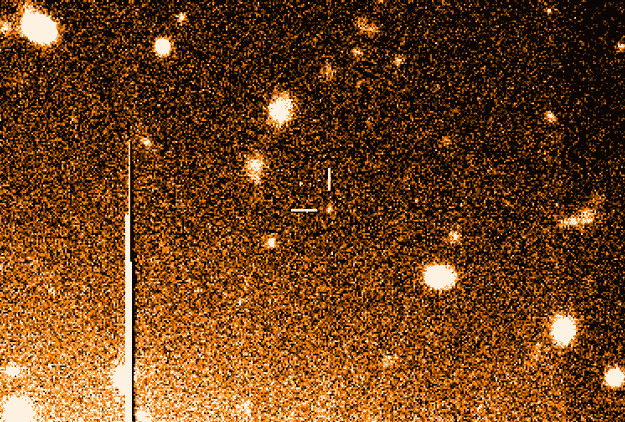Explanation: It happened so far away that common human distance measures are inadequate to describe it. Furthermore, astronomers do not even claim to know exactly what happened. What is known is that satellites across our Solar System reported on 2000 January 31 a tremendous explosion of gamma rays had occurred towards some previously uninteresting direction. Soon one of the largest optical telescopes on Earth, a VLT in Chile, began to peer in the direction of the gamma ray burst. The VLT not only recorded an optical counterpart, shown above, but also was able to estimate that the cosmologically-induced redshift was an astonishing 4.5 -- placing GRB000131 farther across the universe than any explosion so measured. This vast distance indicates that GRB000131 occurred just as galaxies like our Milky Way were forming, and so qualifies gamma ray bursts as unique probes of this ancient epoch. This result bodes well for the recently launched HETE-2 satellite, which may record and help place more explosions in this distant and mysterious time-period of our universe.
1999 2000 2001 2002 2003 2004 2005 2006 2007 2008 2009 2010 2011 2012 2013 2014 2015 2016 2017 2018 2019 2020 2021 2022 2023 2024 2025 |
Yanvar' Fevral' Mart Aprel' Mai Iyun' Iyul' Avgust Sentyabr' Oktyabr' Noyabr' Dekabr' |
NASA Web Site Statements, Warnings, and Disclaimers
NASA Official: Jay Norris. Specific rights apply.
A service of: LHEA at NASA / GSFC
& Michigan Tech. U.
|
Publikacii s klyuchevymi slovami:
gamma-vspleski - gamma-ray burst - cosmology - explosion - afterglow - poslesvechenie - Kosmologiya
Publikacii so slovami: gamma-vspleski - gamma-ray burst - cosmology - explosion - afterglow - poslesvechenie - Kosmologiya | |
Sm. takzhe:
Vse publikacii na tu zhe temu >> | |
